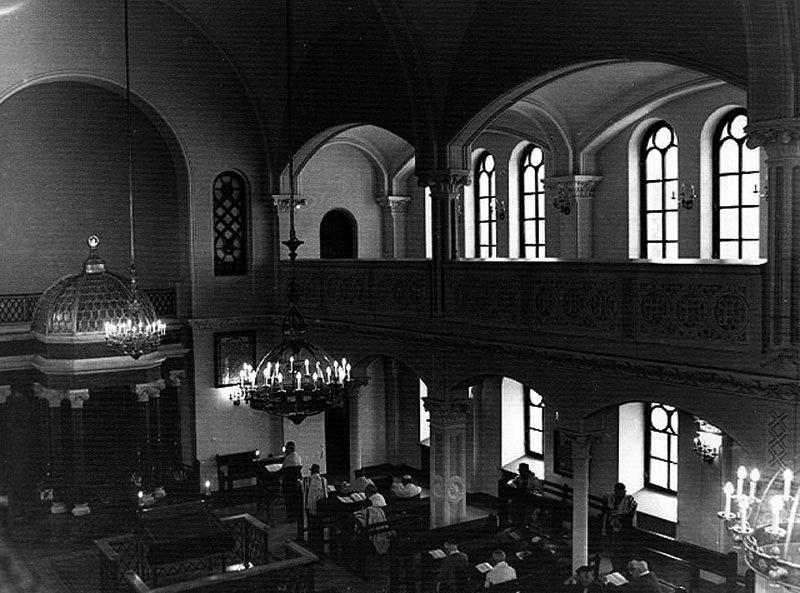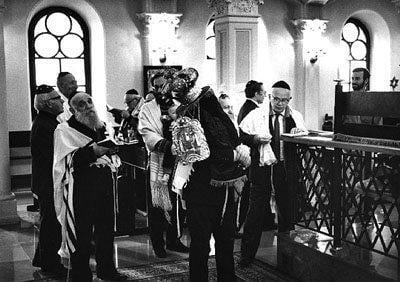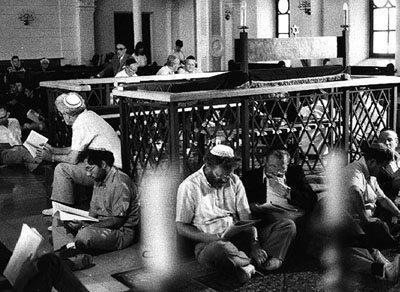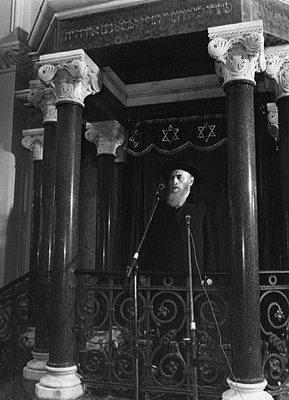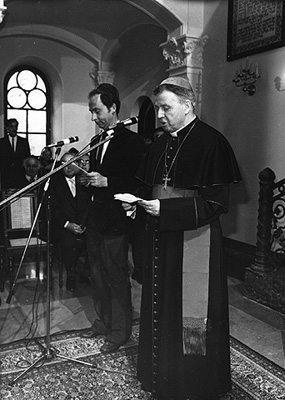The Nozyk Synagogue, Warsaw, Poland
The Nozyk synagogue, the only surviving synagogue from pre-Holocaust years in the Polish capital city is located at 6 Twarda Street in downtown Warsaw. The synagogue was founded by Zelman ben Menashe Nozyk, a wealthy textile merchant, and his wife Rivka (bat Moshe), a childless couple who decided to will their fortune in support of the establishment of a new synagogue in Warsaw. A committee in charge with the building of the synagogue was formed in the early 1890’s. Besides Z. Nozyk, the committee included other distinguished members of the Jewish community in Warsaw: Isaak Ettinger, the banker David Moshe Szereszewski, Arie Leib Dawidsohn – deputy chairman of the Jewish Community of Warsaw, Jechezkiel Krakow, Josef Jechezkiel Zuckerwaar, and B. Rikwert. The cost of the land on Twarda St., purchased for 157,000 rubles in 1893, and the building expenses that amounted to 250,000 rubles, were covered by the donation of Zelman Nozyk. The building work of the synagogue continued for four years from 1898 to 1902 with the inauguration ceremony held on May 12, 1902 – Lag Ba’Omer 5662, when the new synagogue was presented to the Jewish Community of Warsaw. Zelman Nozyk passed away less than one year after the opening of the synagogue (1903) and his wife died in 1914.
Before WW2 the Nozyk synagogue was one of the five largest synagogues in Warsaw. The name of the architect is not known. However, most researchers believe that he must have been one of the three leading architects that were active in other building projects for the Jewish Community of Warsaw during the last decades of 19th century: Leandro Marconi, the Italian architect of the central synagogue of Warsaw on Tlomackie Street; Julius Prechner, a Moscow-based architect of other synagogue projects in Warsaw; or Lew Bachman. The Nozyk synagogue was constructed in the neo-Romanesque style with elements of Byzantine, Romanesque and Moorish ornamentation in an eclectic style that was favored by the architects of a numerous synagogues erected all over Central and Eastern Europe in the second half of the 19th century.
The Nozyk synagogue is a rectangular two-story edifice. The western façade has a portal featuring the two Tablets of the Law and is divided into three sections with the entrance at the center and two high symmetric windows topped by round arches at its sides. The upper floor of the façade is divided into two sections, the lower one has four symmetric windows and the upper one boasts a prominent Magen David (“Star of David”) and a Romanesque style cornice. The lateral walls have a row of round arched windows at each of the two stories, including some blind windows at the ground floor.
The interior has an entrance hall that houses the Yizkor (memorial) table with memorial candles while the women’s section is accessed from a separate entrance and stairway on the southern wall. The main prayer room is divided between the men’s section at the ground floor, and the women’s section at the upper floor located on two galleries supported by arcades of columns at both lateral sides of the hall as well as at the western end. The Holy Ark, a Romanesque-inspired structure with a covering supported by eight columns, is situated at the eastern end. The apse shelters the organ and the place reserved for the choir. The slightly elevated bimah is located at the center of the eastern half of the ground floor. The columns of the prayer hall and the balustrade of the balconies of the women’s section boast Moorish-style decorations in white painted stucco. Originally there were 600 seating places in the prayer hall, divided equally between the men’s and women’s sections.
The building was renovated in 1923, twenty five years after its opening. To mark the event a festive service was conducted by the famous cantor Gershon Sirota (1874-1943) and the choir founded by Abraham Zvi Dawidowicz (1877-1942). Throughout the years between the two world wars, the Nozyk synagogue was renowned for its splendid services conducted by some of the leading cantors of the period.
During the German occupation of Warsaw in the Second World War, the Nozyk synagogue was initially included within the limits of the ghetto (“the Little Ghetto”), but after the area of the ghetto was later reduced, the synagogue was left outside the boundaries of the ghetto. Jews were allowed to pray in the Nozyk synagogue until the autumn of 1941. Then the synagogue was desecrated and the building was used by the Germans alternatively as a horse stable and a fodder storehouse. In addition, the synagogue suffered serious damage during the street battles and bombardments that followed the Polish uprising in the summer of 1944.
At the end of the Second World War, the building underwent basic repairs and was reopened for public worship in the late 1940’s. Some other basic maintenance works were done in the early 1950’s.
A thorough reconstruction of the synagogue was conducted after 1977 under the supervision of architects Hanna Szczepanowska and Eva Dziedzic. It was within the frameworks of this project that the building sheltering the offices of the Jewish Community of Warsaw (known during the years of the Communist regime as the Religious Union of the Mosaic Faith in the Polish People’s Republic) was added at the eastern wall. The official opening of the restored synagogue took place on the occasion of the 50th anniversary of the uprising of the Warsaw Ghetto on April 18, 1983. The opening ceremony was attended by Jewish leaders from Poland and other countries as well as representatives of the Catholic Church in Poland.
The Nozyk synagogue was targeted by a number of anti-Semitic assaults in the 1990’s, in the most serious incident the main entrance and front hall were severely damaged by arsonists in early 1997.
In June 2005 a new Torah scroll was brought to the Nozyk synagogue. Originally from the destroyed Tlomackie St. synagogue of Warsaw, the 1876 Torah scroll was returned back to Poland from the USA in a festive ceremony led by the Chief Rabbi of Poland, Michael Schudrich and attended, among others, by 129 IDF soldiers, who carried it through the streets of Warsaw to the Nozyk synagogue. The Nozyk synagogue, which is Orthodox, serves the small Jewish community of Warsaw and services are held daily and on Jewish holidays.
Address:
Nozyk Synagogue
6 Twarda St.
Warsaw 00-104
Poland
Tel: 48-22-620 3496
